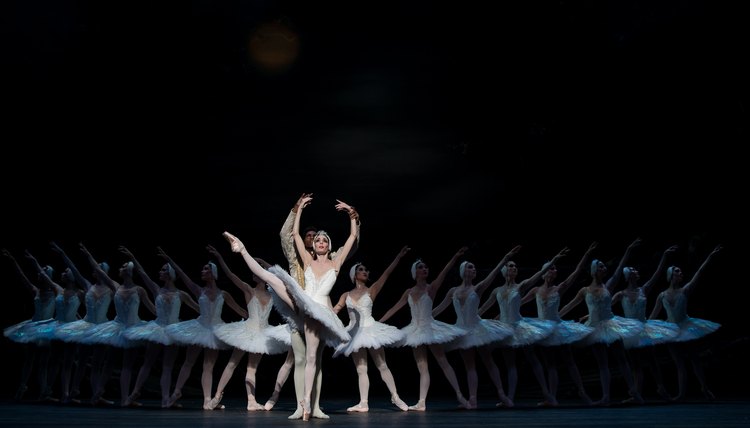What Is a Ballet Leg Line?

A perfect leg line is what makes us all marvel at a great ballet photo. It’s what makes the ballet dancer appear effortless, fluid and beautiful onstage. That’s according to ballet teacher and professional ballerina April Longo. Ballet dancers are not just athletes; they are also artists. The graceful line their legs make is imperative to the performing art of ballet. “It’s not necessarily how high a dancer’s leg is; it is the placement and extension and shape of the leg and foot that makes us stop and pay attention,” Longo says.
Definition
The ballet leg line is the outline of the legs the ballet dancer presents while performing steps, according to American Ballet Theatre’s ballet dictionary. “The line of the leg in ballet should be long and seem infinite,” Longo says. “The perfect look of the ballet leg line is created by correct muscle formation in the legs and the proper shape of the foot.”
A ballet leg line is comprised of turned-out legs that are rotated outward from the hips. The feet are also turned out and pointed. One of the most basic steps in ballet -- the first arabesque -- is an example of the ballet leg line in action. In the position, the dancer stands on one leg and raises the other directly behind her at 90 degrees or higher. The shoulders are square and facing forward with the arms outstretched, one in front and one to the side. The object is to create the longest possible line from the fingertips all the way to the toes. Ballet teachers often point to slightly hyperextended legs to form the best natural ballet leg lines with a slight upper-curve. A hyperextended leg curves just inward when the leg is straight. In the arabesque position, the slight curve offsets the arch of the foot, according to “Dance Magazine.”
Importance
A good ballet leg line is not only paramount; it’s what separates the quality and level of dancers. “The line of your leg in ballet is important because it is an element that gives a dancer the refined quality that separates a great dancer from a good one,” Longo says. “Anyone can put their leg behind them and call it arabesque. But it is the way the leg gets there and the line of the leg that makes it ballet.” Dancers constantly train during class with the help of floor-length mirrors to achieve the coveted ballet line. “In advanced level ballet classes, a lot of attention is given to the line of a dancer’s body, and specifically the line of the leg,” Longo says.
Tips
Several elements influence your ballet line, including the muscle formation in your legs, the natural shape and length of your particular body, the flexibility of the ankles and correct alignment to name a few, according to Longo. The hard work to achieve the ideal leg line is done through repetitive practice in ballet class. The structure and exercises in ballet classes are designed to create a long leg line, constantly elongating and stretching your muscles. Learning to execute ballet steps well is only the first phase. “But, (students) also need to pay attention to the details of how they are working their body,” Longo says. “Each student should use the mirror as a tool to evaluate their line. Small corrections to the leg and foot can make a big difference in the line that is created.”
Pitfalls
Though many teachers look for hyperextended legs to achieve the so-called perfect ballet leg line, hyperextended legs can also cause problems. Dancers with naturally hyperextended legs -- sometimes extremely hyperextended -- can have weak external rotator muscles, making the legs prone to collapsing inward when landing a jump, according to “Dance Magazine.” The danger is damage to the joints and mis-alignment of the leg, risking twisted knees and sprained ankles, the magazine reports. Even if you’re not born with hyperextended legs or a naturally high-arched and well-pointed foot, cheating a better leg leg line by “winging” the foot is also dangerous. When dancers force their heels forward -- known as winging the foot -- it alters the alignment of the ankle, according to “DanceTeacher” magazine. Winging your foot during a weight-bearing exercise can overstress tendons on the inside of the foot and twist knees over time, according to the magazine. The opposite of winging is sickling, when the ankle bends inward. Sickling not only breaks the line of the leg, it also can lead to the same types of injuries, including ankle sprains, “DanceTeacher” reports.
References
Resources
Writer Bio
Mikel Chavers has been writing and editing since 2006, specializing in health, business, government and technology topics. She got her start as a reporter at “The Business Journal” in Greensboro, N.C., and later covered state government for a national magazine. Chavers holds a Bachelor of Arts in media studies/journalism.
